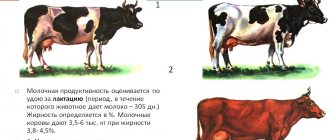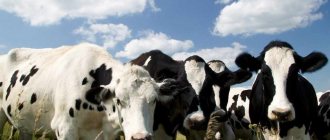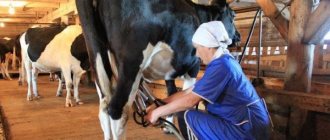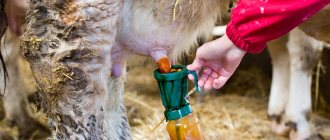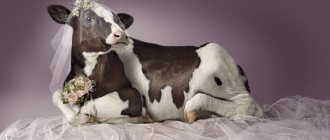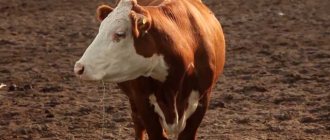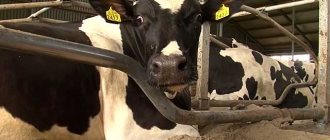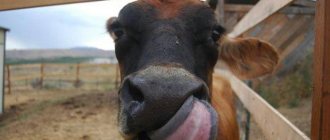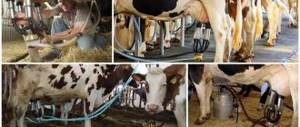Interesting facts about cows
What would the world be like without cows, or more precisely, what would have happened if people had not domesticated them since time immemorial? A number of industries have depended on these animals for many centuries. Cows provide milk, meat, and hides, and in some cases everything else is used, including manure, horns and hooves. Perhaps we should be grateful to them for the contribution they made to the development of our civilization.
Facts about cows
- Their pregnancy lasts as long as that of humans, plus or minus a few weeks.
- Since the late 1980s, cow embryos have sometimes been cloned to produce suitable individuals.
- No one knows exactly when cows were domesticated. It is known for certain that at least 6,000 years ago in Ancient Egypt, they were already tamed, and in the territory of modern Turkey, archaeologists found the fossil remains of a domestic cow, which is more than 10,000 years old (interesting facts about Ancient Egypt).
- Some diseases that cows are susceptible to can be transmitted to humans, and vice versa.
- There are also hornless species of cows in the world.
- In total, about 1.3 billion cows now live on Earth.
- The total weight of all these animals is approximately 3 times the total mass of all humanity.
- Cow's eyes give them excellent visibility, making it very difficult for a predator to sneak up on this artiodactyl.
- In India, the cow is revered as a sacred animal. But this hardly applies to the Indian state of Goa, popular among tourists, since the bulk of its population are Christians, not Hindus (interesting facts about India).
- About 15-18% of all greenhouse gases are released into the Earth's atmosphere due to cows. Methane is actively produced in their stomachs, which contributes to the greenhouse effect.
- In recent decades, breeding dwarf cows has become popular in some countries. However, in terms of height at the withers, they still reach the waist of an adult man.
- The world's largest cow, listed in the Guinness Book of Records, lived at the beginning of the 20th century. Her weight was just shy of 2.3 tons, and her height at the withers reached 188 centimeters.
- Argentina occupies the first place in the world in beef production, and the largest herds, numbering millions of cows, graze in the vastness of this country (interesting facts about Argentina).
- These animals are one of the few on Earth that remember people by their faces, and not by smells and other distinctive features.
- They easily remember their name and respond obediently to it.
- To produce 1 ton of milk daily, you need a herd of approximately 50-60 dairy cows.
- The most expensive beef in the world is the meat of Wagiu cows, which have been bred only in Japan for centuries.
- Like people, these artiodactyls can cry.
- Before money in one form or another came into use almost throughout the world, cows often acted as a measure of value. The larger a man's herd, the richer he was. For some peoples, wealth was similarly measured in camels, rams and horses (interesting facts about camels).
- Cows cannot distinguish colors, so the saying about bulls and their aggressiveness when they see the color red has nothing to do with reality.
- In Medieval Europe, courts sometimes tried cows in the same way as people. The animal could have been convicted of some crime, such as assault.
- In the modern world, killing a cow is sometimes equated to killing a person. This law applies, for example, on the island of Cuba.
- These artiodactyls are able to sense the Earth’s magnetic field, and when resting they are always located along its lines, if they have such an opportunity.
- With their mooing in 11 different intonations, they communicate with each other.
- The number of cows in South America is almost equal to the population of the entire continent. According to statistics, there are 9 cows for every 10 people here (interesting facts about South America).
- If a cow licks you with her tongue, it means she likes you.
- A cow's nose print is as unique as human fingerprints.
- On average, one dairy cow produces about 200 thousand standard glasses of milk over the course of its life.
- The life expectancy of cows is about a quarter longer than that of bulls - about 20 years versus 15.
- In terms of population size among all mammals, cows occupy the second place on Earth, second only to humans.
- Interesting facts about milk
- Interesting facts about goats
- Interesting facts about rhinoceroses
- Interesting facts about Egypt
- Interesting facts about chickens
- Interesting facts about Ancient Egypt
- Interesting facts about dolphins
- Interesting facts about sugar
Cow nutrition
The most beautiful types of indoor geraniums
This is a herbivore from the ruminant breed. For the winter, grain crops, beets, corn, hay and silage are prepared for them. Dairy breeds will produce more milk if you include feed and mineral supplements in their diet. It is imperative that the cow receives a certain amount of salt and water. In the summer they are driven out to pastures, where they happily eat green grass. Caring for a cow is not difficult, but it requires constant attention. Only with good care and careful attention to it can you achieve good milk yield. If you don't keep the animal clean, it can get sick.
It is imperative to stock up on straw for the winter in order to lay it under the animal’s feet. If she is not milked on time, she may be at risk of mastitis or complete loss of milk. Domestic agriculture can be said to mostly rely on this animal. People can no longer imagine how there can be no milk, sour cream, cottage cheese and all the dishes that can be prepared with their help on the table. From all this it follows why the cow is a sacred animal in India. The cow does not eat quite normally, not like most animals. To digest food, it has four chambers in its stomach. While the cow is grazing, she swallows grass without chewing it.
Then, when it’s time to rest, she regurgitates a certain amount of food and chews it with her teeth in a calm environment. The already ground grass now only enters the last chambers of the stomach. Bacteria and gastric juice help break down food. Often newcomers to agriculture who want to get a cow are interested in how much hay a cow needs for the winter? For a long time, people, although they were not very literate, calculated the approximate amount of hay. A cow requires an average of 6 tons of hay
It is important to know one more secret - the warmer the habitat of this animal, the less hay is needed and vice versa
Jersey cow breed
Origin and distribution
It is considered one of the oldest and fatty milk cultural varieties. It got its name in honor of one of the Channel Islands - Jersey, where they began to breed it as breeding stock, using genetic material from Norman and British cattle. For a long time it retained its purebred status due to the government ban on the export of breeding stock. The stud book for the Jersey breed was established in 1866. Jersey animals were first exported outside their homeland only at the beginning of the 19th century: first to England and the USA, and later to Australia, Africa and New Zealand, where they live today. In addition, they are widespread in Denmark, Canada and France, as well as in the Voronezh and Moscow regions of Russia.
Description of the Jersey cow breed
Representatives of this cattle are characterized by a long loin and wide rear, obliquely set rounded ribs, a long and flat neck and a narrow deep chest. The animals have a wide depressed forehead, a short facial part of the skull and fairly developed eye sockets, and often sharp and high withers. At times there are deviations in the exterior and constitution. This breed is distinguished by light brown, red, and less often dark colors. Weight ranges from 600-700 kg for bulls and 360-400 kg for cows. Milk yield per year averages 5-5.5 tons of milk, the fat content of the product is 5–6%, in some places it can reach 7%, the protein content of milk is 4%.
Beefalo
This breed was deliberately bred by genetic engineers by crossing a buffalo with a beef breed of cow. People wanted to get a strong, meat breed that could be kept outdoors even in winter and be unpretentious in food. How to distinguish this unusual hybrid:
- The weight of a bull reaches 1200 kilograms, making it a very impressive beast;
- The hybrid can indeed survive in the open air and feed on its own even in winter;
- Long brown fur, thick skin, a furry muzzle with a goatee and a pair of horns.
Angus mini cows
Miniature Angus cows are also among the dwarf cow breeds. Unlike the above representatives, they have relatives of standard size. Angus cows were bred back in the 19th century. in the vicinity of the counties of Anguss and Arbedin (north-east Scotland).
The color of this breed is predominantly black. Representatives of the red color are much less common.
The physique of these cows fully corresponds to the characteristics characteristic of the meat type: the rounded body is supported by short legs, due to the retracted neck, the head seems to merge with the body, well-developed muscles are clearly visible. The live weight of a six-month-old calf is about 400 kg, and an adult calf is 750 kg or more.
The height of the animal at the withers can exceed 150 cm. The proportion of bones in the carcass does not exceed 16%. Their meat is marbled beef (with thin layers of fat) of excellent quality.
Cow lifestyle
For several thousand years, cows have lived next to people. During this time, people managed to thoroughly study the lifestyle, habits and preferences of these animals. The cow, a domestic animal, has its own tastes in food and even in music. Yes, scientists have found that cows are true music connoisseurs. If they like a certain melody, and the owner periodically plays it specifically for the cow, then milk yield may increase. They can recognize a melody by its rhythm. And cow connoisseurs distinguish about 11 melodies in their mooing.
This animal belongs to the ruminant suborder. This is a female domestic bull. Their children are called calves and heifers. Currently, meat, dairy and meat-and-milk cows are used in agriculture. The weight and size of cows depends on their breed. Nowadays, dwarf cow breeds are in fashion. They can weigh from 250 kg. The smallest is in England. Her height is only 80 cm. On average, a normal cow weighs from 750 to 1400 kg. The size of this animal depends on the direction of the farm. If it is a meat breed, then it is accordingly always larger than a dairy breed. The color of cows can be very different, ranging from white and cream to black. It depends on the animal's habitat.
Buying a cow nowadays is almost the same as buying a used car. The price of a cow depends on the purpose for which it is purchased. Meat usually costs less than dairy.

